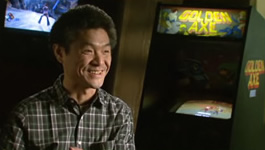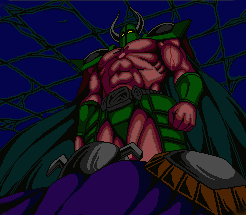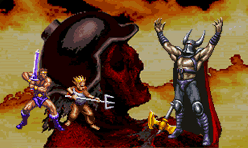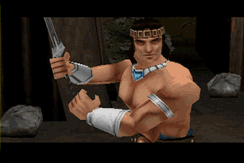Legendary. Classic. Timeless. These are only a few of the adjectives one could use to describe the Golden Axe franchise, which has been sorely abandoned for  the last few years. Back in 1989, any arcade worth its salt had a Golden Axe unit prominently displayed. Gamers went wild for it and Sega had yet another hit to add to its repertoire of classics.
the last few years. Back in 1989, any arcade worth its salt had a Golden Axe unit prominently displayed. Gamers went wild for it and Sega had yet another hit to add to its repertoire of classics.
The arcade original spawned a Genesis port with two sequels, an incredible Master System Zelda clone, a Game Gear action/RPG, as well as two more arcade games (the worst of which was ported to the Saturn). So many games and then nothing. That is, until Sega decided to bring Golden Axe back for its Sega Ages series on the PlayStation 2. How well did that fair? Well, let’s not get ahead of ourselves, shall we?
Developer History
Sega had a string of arcade hits during the 1980s that would eventually find their way to their struggling Master System. When the Genesis was released in 1989, the company was determined to convince gamers that the system could offer ports as close to the arcade as possible; something Nintendo’s aging NES could not do.
Golden Axe is the brainchild of one Makoto Uchida (creator of Altered Beast, director of Dynamite Cop, and producer of Alien Front Online). Uchida first joined Sega in 1987 as part of one of their premier internal development teams, AM1 R&D Division (later called Overworks and then WoW Entertainment). There, he created classics like Altered Beast (inspired from Michael Jackson’s Thriller video), and Alien Storm. 1989 saw what would go on to be his most successful creation: Golden Axe.
The Games
Probably the single most interesting thing about Golden Axe is how it came about. Originally, it was never intended to be a hack-‘n-slash adventure. After creating the 1988 arcade mega-hit Altered Beast, Uchida wanted to craft a lavish and involved RPG similar to Enix’s Dragon Quest (Dragon Warrior for all you non-import types) but the executives at Sega weren’t too enamored with his vision. Wanting to appeal to the quarter munching style of business that arcades produced, they had the concept changed to something simpler. Inspired by the 1982 Arnold Schwarzenegger hit Conan the Barbarian, Uchida and his tiny team of only five people went back to work and came up with a game anyone could play from the get-go but that also required some practice (which ensured multiple plays). Golden Axe was released in arcades in 1989 and quickly became a huge hit. Players could choose from one of three awesome characters: Ax Battler, the powerful barbarian, Tyris Flare, a fierce Amazonian warrior, and Gilius Thunderhead, the small but wily dwarf. Two people could tackle Death Adder’s minions together and there were beasts to ride, magic to collect, and lots of foes to kill.
What probably awed gamers the most was the incredible magic effects each character possessed. When you tapped that button and unleashed the full load of your power, it actually felt like you were doing some serious damage. The earth shook, explosions rocked the screen, and enemies lit up like a disco ball on a Saturday night. Tell me you weren’t impressed by Tyris’ dragon magic the first time you saw it!
Sega was well aware of what they had on their hands and quickly saw the potential of porting the game over to their new Genesis console, which was going to be in need of some arcade muscle for its American debut. It was released soon after the system launched and immediately became the game to own. Gamers everywhere saw just how close (although not quite perfect) the Genesis could emulate the arcade experience and sales of the console began to slowly gain steam. To many, Golden Axe was considered the premier piece of software that sold Genesis systems before the debut of a certain blue hedgehog.
 So great was the success of Sega’s hack-‘n-slasher that it was even released in Japan for the PC-Engine, which was steadily trouncing the Mega Drive. Sega had licensed out versions of its arcade hits to the competition before, namely Fantasy Zone and Shinobi for both the TurboGrafx-16 and NES, as well as Alien Syndrome on the NES. Telenet, of Valis fame, handled the port and in a rare instance screwed it up entirely. Piss-poor graphics and horrible control mired what should have been the best port of them all, given that it was released on CD-ROM 2 hardware. Even something as fundamental as the animated cut scenes, for which Telenet was widely known, went terribly wrong. U.S. gamers went blissfully unaware for years of how bad the port turned out, gazing over screen shots and daydreaming of a CD-based Golden Axe. Thankfully, Sega allowed this nightmare to remain in Japan, sparing the brand from a wretched stain. It was a policy they would soon lamentably abandon.
So great was the success of Sega’s hack-‘n-slasher that it was even released in Japan for the PC-Engine, which was steadily trouncing the Mega Drive. Sega had licensed out versions of its arcade hits to the competition before, namely Fantasy Zone and Shinobi for both the TurboGrafx-16 and NES, as well as Alien Syndrome on the NES. Telenet, of Valis fame, handled the port and in a rare instance screwed it up entirely. Piss-poor graphics and horrible control mired what should have been the best port of them all, given that it was released on CD-ROM 2 hardware. Even something as fundamental as the animated cut scenes, for which Telenet was widely known, went terribly wrong. U.S. gamers went blissfully unaware for years of how bad the port turned out, gazing over screen shots and daydreaming of a CD-based Golden Axe. Thankfully, Sega allowed this nightmare to remain in Japan, sparing the brand from a wretched stain. It was a policy they would soon lamentably abandon.
Of course, all successful games must have sequels, and Genesis owners didn’t have to wait too long for one, as Sega gave them Golden Axe II in 1991. Although solid in its own right, it failed to surpass the original. Very few gameplay innovations had been made, making it seem too much like the first. Ordinarily, that wouldn’t have been a bad thing, but considering that almost two years and a generation of Genesis software had passed since the first game had been released, it was a bit of a letdown. The original characters returned and the graphics received a facelift, but something wasn’t quite… right. The magic was less impressive, the sounds were muffled, and the whole thing just seemed off. The charm of the original was gone. This became a trend with the series, and only two other games bearing the name (neither of which were on the Genesis) reached the same level of quality Golden Axe possessed. Uchiba’s masterpiece had set the bar very high indeed.
For example, After its rampant success on Sega’s 16-bit darling, the original Golden Axe was ported to the Sega Master System. A watered down version of an already not-arcade-perfect port, the 8-bit version suffered from a myriad of problems, including slowdown, only one playable character, and the omission of the two-player mode. Still, Master System fans were gasping for just about anything at this point and it was nice of Sega to remember them.
Actually, Sega did more than that. The Master System also received a Golden Axe exclusive in 1991, in the action/RPG Golden Axe Warrior. Basically a clone of Nintendo’s Zelda, Warrior sent the gamer out to find the nine magic crystals that Death Adder had hidden throughout the kingdom of Firewood (strange name for a kingdom). It was quite a departure from the standard hack-‘n-slash gameplay of the series so far, but was well received by critics and those few who still owned the console. Decent graphics and a fun quest made it a title worthy of the franchise and well worth owning a Master System for. It was one of the last games released for the beleaguered 8-bitter and has never been re-released anywhere else. The different style of play was both refreshing and engaging, and it would be interesting to see it revisited at some point in the future. A Golden Axe RPG using a Knights of the Old Republic-style play system would be mouth watering to say the least.
The Game Gear, Sega’s answer to the Game Boy, also got in on the action with a neat little action/RPG of its own. Ax Battler: A Legend of Golden Axe came out in 1992 and lifted another page from the Zelda mythos, this time emulating the gameplay style of Link’s Adventure. An overhead map view changed to side action when you entered a cave or combat. As Ax Battler, one of the three original heroes, you were once more tasked with retrieving the legendary Golden Axe and restoring peace to the land of Firewood. Although the play control was a bit wonky at times, the game was fun and it was yet another interesting direction for the series. Ax Battler was a competent little action/RPG and deserves to be re-released in some form (along with Defender of Oasis!). I could very well vision this being an extra in some fantasy Golden Axe Mega Collection or something. Hey, it worked for Sonic!
While it seemed that every Sega console under the sun was getting a Golden Axe game, Sega did not forget the series’ roots and gave arcade goers another hole into which to toss their money. Revenge of Death Adder is regarded by most to be the true sequel to the first game and upon playing it, one can easily see why. It went back to the standard hack-‘n-slash style of the first two installments and pulled out all the stops, taking full advantage of Sega’s powerful System 32 hardware. Among its features were simultaneous play for up to four people, huge sprites, and some great magic effects. Of the original three heroes, only Gilius returned (he rides on the back of Goah, an axe-wielding giant) and he was accompanied this time by Dora (a centaur), Little Trix (a elf-like boy with a pitchfork), and Sternblade; who happened to look very much like Ax Battler. I guess Sega thought it just wouldn’t be a medieval sword adventure without some form of barbarian to use. Of all of them, Little Trix was the most ideal choice, as his magic created instant apple trees that players could pick and eat from to replenish their health. For this reason, any hopes of getting far into the game without going broke definitely required someone to play medic and use him.
 The tried and true arcade gameplay formula remained intact and there was little change. The difference between Revenge and Golden Axe II is that the developers of the coin-op were actually inspired to build a memorable game around that dynamic. With forward-scrolling stages (usually running from large boulders), mini games to get power ups, and more rideable beasts than ever, Revenge left gamers hungering for more. In typical Sega fashion, however, it was never released for the home market. Most people had assumed that it was slated for a Saturn release (a launch title if I’d ever seen one), but it never materialized. I have no idea why Sega passed on it, since it was successful in arcades and the Saturn hardware was practically made for games like it. A ROM has been floating around the web, but it’s glitchy and locks up occasionally. An incredible arcade game that was overshadowed by fighting game mania, Revenge of Death Adder screams for a second chance. How long Sega will turn a deaf ear remains to be seen.
The tried and true arcade gameplay formula remained intact and there was little change. The difference between Revenge and Golden Axe II is that the developers of the coin-op were actually inspired to build a memorable game around that dynamic. With forward-scrolling stages (usually running from large boulders), mini games to get power ups, and more rideable beasts than ever, Revenge left gamers hungering for more. In typical Sega fashion, however, it was never released for the home market. Most people had assumed that it was slated for a Saturn release (a launch title if I’d ever seen one), but it never materialized. I have no idea why Sega passed on it, since it was successful in arcades and the Saturn hardware was practically made for games like it. A ROM has been floating around the web, but it’s glitchy and locks up occasionally. An incredible arcade game that was overshadowed by fighting game mania, Revenge of Death Adder screams for a second chance. How long Sega will turn a deaf ear remains to be seen.
At the same time Genesis owners were praying for a release of Revenge (Sega CD perhaps?), Sega of Japan was quietly working on a separate, third installment for their aging console. Golden Axe III landed in 1993 with such a loud thud that it was denied an American release. Fans, not knowing why it had been canceled, were outraged at being left out in the cold again, after having been teased with tantalizing screen shots and previews. The ironic thing is that those shots did little to actual convey just how bad Golden Axe III really was. I’ve heard people attempt to defend it and granted, had it borne any other name, it might have been a half-decent attempt at a GA clone. The fact is, however, that it is part of the Golden Axe series and without a doubt a pox upon the franchise.
Gilius was no longer a playable character. Replacing him and his legendary comrades were some of the weakest warriors ever to save humanity. Another Amazon-like female, a werepanther and gladiator (still in shackles) attempted to balance things but failed miserably. Why didn’t Sega learn from games like Streets of Rage and incorporate some buddy moves or interaction with the backgrounds or let players use logs or barrels as weapons?
As if this weren’t enough, the game was a significant step down visually from others in the series. It almost looked worse than the first, with only a bare minimum of parallax giving it the edge. The only redeeming feature that I could see was the inclusion of branching paths. Should anyone have felt the need to play through Golden Axe III more than once, they at least didn’t have to suffer through the same levels the second time around.
I guess the worst part about Golden Axe III was the lost potential. At this late point in the Genesis’ life cycle, great things were expected. With titles like Gunstar Heroes being released the same year, there was simply no excuse for such a lazy hack job. I think Rob “Dire51” from Digital Press said it best:
“Golden Axe was the major motion picture, Golden Axe II was the direct-to-video sequel, and Golden Axe III was the made-for-TV movie.”
I should add though, that he actually did enjoy the game.
It appeared that Sega felt that the best success was to still be had in the arcade, so in 1994 they released the brawler Golden Axe: The Duel, on their Sega Titan ST-V board. The third genre to feature a game from the series, the result was a mediocre fighter that looked more like a cash run than a serious contender. An all-new cast of warriors emerged to battle for what was believed to be the recently rediscovered Golden Axe. The descendants of both Gilius and Tyris were selectable but the rest of the cast was uninspired to say the least. Ironically enough, Sega thought that The Duel was worthy of a home release and ported it to the Saturn in 1995. The standard rationale is that the Saturn’s main strength was its library of Sega arcade games, and The Duel was still fresh in gamer’s minds. If this were entirely true, however, we would no doubt have seen Revenge of Death Adder on the ill-fated console.
The Duel would also have the unfortunate distinction of being the last new Golden Axe game released for another decade. The franchise as a whole seemingly disappeared in the latter half of the 1990s. It only made a a few appearances aside from the Saturn fighter, being included in several compilations, including the underwhelming Sega Arcade Classics 5-in-1 collection in 1995 (which was supposed to have ten games but never got past five, in two separate releases) and the Sega Smash Pack for both the Dreamcast and PC. Everyone considered the once proud line to have gone the way of Alex Kidd and Wonder Boy until Sega announced a revival of the franchise via its Sega Ages label in 2003. Reason to rejoice? Think again.
 Remember earlier when I said that we shouldn’t get ahead of ourselves? Unfortunately, the time has finally come to face the music. Similar to what they did with Revenge of Shinobi and Altered Beast on the GBA, Sega farmed out the re-release of Golden Axe to another developer. In this case, it was 3D Ages that would step up and do their dirty work. And I mean nasty, crappy, looks-like-a-rushed-homebrew effort dirty. If you thought that Sega was through crapping all over this series when it let Telenet soil the original on the PC-Engine, released Golden Axe III, and then gave us The Duel instead of Revenge of Death Adder on the Saturn, think again. They’ve saved their worst for PlayStation 2 owners looking for a yet another reason as to laugh about how Sega is no longer the company it once was.
Remember earlier when I said that we shouldn’t get ahead of ourselves? Unfortunately, the time has finally come to face the music. Similar to what they did with Revenge of Shinobi and Altered Beast on the GBA, Sega farmed out the re-release of Golden Axe to another developer. In this case, it was 3D Ages that would step up and do their dirty work. And I mean nasty, crappy, looks-like-a-rushed-homebrew effort dirty. If you thought that Sega was through crapping all over this series when it let Telenet soil the original on the PC-Engine, released Golden Axe III, and then gave us The Duel instead of Revenge of Death Adder on the Saturn, think again. They’ve saved their worst for PlayStation 2 owners looking for a yet another reason as to laugh about how Sega is no longer the company it once was.
To say that the Sega Ages version of Golden Axe is bad is like saying that chemotherapy is a minor inconvenience. Horrible, PS one-level graphics only paint a small corner of the canvas that is this abomination. The levels have been completely redone (although the branching paths are nice) and are now painfully long. Even worse, the neat little cut scenes from the original have been butchered. They’ve been replaced with in-game scenes that cannot be skipped. It’s almost as if the developers wanted to make players suffer through the graphics for as long as possible. Further tainting the legacy, the famous imps who stole your magic after each level are gone and even the character select screen has been removed. We waited nine years for this? Even compared to the other Sega Ages games, Golden Axe stands out like a sore thumb. Tighter control and a great soundtrack can do little to make this playable.
No More Axes to Grind?
As it stands, Sega seems to finally be interested in bringing the franchise back from the dead. Developer Secret Level has been working on something of a prequel to the first game, called Golden Axe: Beast Rider, starring Tyris Flare. Concentrating on the numerous usable creatures the series is known for, it’s more of a reboot than anything else, and its 2008 release might yet set the stage for future titles. In the meantime, the fans have refused to let Golden Axe die, as is evident in such projects like 1998’s Golden Axe: The Rise of Death Adder, which was a homebrew game using the Neverwinter Nights engine. There’s also a great Golden Axe: Curse of Death Adder mod in the works for PC over at Gamakazi! It uses sprites and backgrounds from the arcade Golden Axe games, as well as from other medieval coin-ops.
The complete release chronology is as follows:
- Golden Axe, arcade (1989)
- Golden Axe, Genesis (1989)
- Golden Axe, Master System (1989)
- Golden Axe, Amiga (1989)
- Golden Axe, Commodore 64 (1989)
- Golden Axe, Sinclair ZX Spectrum (1989)
- Golden Axe, DOS (1990)
- Golden Axe, Amstrad CPC (1990)
- Golden Axe, Atari ST (1990)
- Golden Axe, NEC PC-Engine (1990)
- Golden Axe, Commodore Amiga (1991)
- Golden Axe II, Genesis (1991)
- Golden Axe Warrior, Master System (1991)
- Axe Battler: A Legend of Golden Axe, Game Gear (1992)
- Golden Axe: Revenge of Death Adder, arcade (1992)
- Golden Axe, Sega CD [Sega Arcade Classics 4-in-1] (1992)
- Golden Axe III, Mega Drive (1993)
- Golden Axe, Sega CD [Sega Arcade Classics 5-in-1] (1993)
- Golden Axe, Mega Drive [MegaGames 3-1cart] (1994)
- Golden Axe: The Duel, arcade (1994)
- Golden Axe: The Duel, Saturn (1995)
- Golden Axe, Genesis [Sega Classics version] (1995)
- Golden Axe, PC-CDROM [Sega Smash Pack Vol. 1] (1999)
- Golden Axe, Dreamcast [Sega Smash Pack Vol. 1] (2000)
- Golden Axe, Bandai Wonderswan (2002)
- Golden Axe, Playstation 2 [Sega Ages 2500 label] (2003)
- Golden Axe II, Nintendo Wii [Virtual Console] (2007)
- Golden Axe III, Nintendo Wii [Virtual Console] (2007)
- Golden Axe: Beast Rider, Xbox 360/Playstation 3 (2008)
Sources
- Game Info. Multiple titles. Death Adder’s Castle.
- Game Info. Golden Axe: The Duel. Killer List of Video Games.
- Game Info. Revenge of Death Adder. Killer List of Video Games.
- Sega Ages: Golden Axe. IGN. June 9, 2004.

But our wish will finally be granted, as Golden Axe: The Revenge Of Death Adder is getting a long overdue home release via the Arcade 1Up very soon! It still may not exactly be an official console release, but it’s far better than nothing, and late than never too!
Thanks for pointing out the errors about GA III and The Duel. I’ve amended the article.
Tyrus Flare, and Ax Battler were NOT in Golden Axe 3, even if their replacements were obviously similar. That, and Death Adder wasn’t either (as the final boss isn’t him), so Sega did get it right with what they said on Golden Axe: The Duel’s description. That game was probably ported to Sega Saturn, because most gamers wanted fighting games then, and made for an easy conversion, since the it ran off the same arcade hardware the Saturn was based off of. I highly doubt we’ll ever see Golden Axe: The Revenge Of Death Adder ever ported, since Sega lost the source code to the game, which sucks, as it was by far the best one in the series. I actually thought the PS2 G.A. remake was fairly okay, even if I seem to be in the minority when it comes to that. Yeah it had flaws, but wasn’t exactly totally horrible, nor unplayable by any means I.M.O., while the soundtrack was nothing short of totally amazing as well. It’s worth a try at the very least.
I do hope that M2 will work there magic in porting Golden Axe: The Revenge of Death Adder for the Switch’s Sega Ages series.